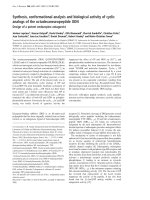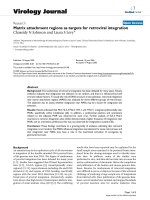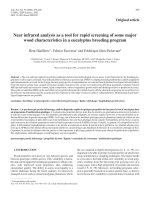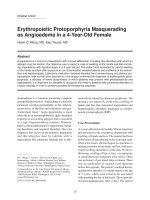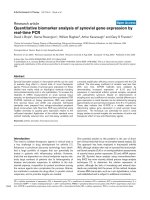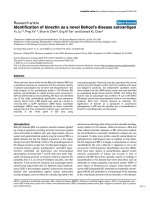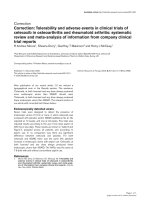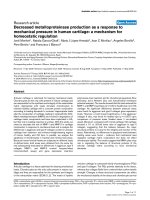Báo cáo y học: "Time series analysis as input for clinical predictive " ppt
Bạn đang xem bản rút gọn của tài liệu. Xem và tải ngay bản đầy đủ của tài liệu tại đây (3.58 MB, 55 trang )
This Provisional PDF corresponds to the article as it appeared upon acceptance. Fully formatted
PDF and full text (HTML) versions will be made available soon.
Time series analysis as input for clinical predictive modeling: Modeling cardiac
arrest in a pediatric ICU
Theoretical Biology and Medical Modelling 2011, 8:40 doi:10.1186/1742-4682-8-40
Curtis E Kennedy ()
James P Turley ()
ISSN 1742-4682
Article type Research
Submission date 22 November 2010
Acceptance date 24 October 2011
Publication date 24 October 2011
Article URL />This peer-reviewed article was published immediately upon acceptance. It can be downloaded,
printed and distributed freely for any purposes (see copyright notice below).
Articles in TBioMed are listed in PubMed and archived at PubMed Central.
For information about publishing your research in TBioMed or any BioMed Central journal, go to
/>For information about other BioMed Central publications go to
/>Theoretical Biology and
Medical Modelling
© 2011 Kennedy and Turley ; licensee BioMed Central Ltd.
This is an open access article distributed under the terms of the Creative Commons Attribution License ( />which permits unrestricted use, distribution, and reproduction in any medium, provided the original work is properly cited.
1
Time series analysis as input for clinical predictive modeling:
Modeling cardiac arrest in a pediatric ICU
Curtis E. Kennedy
1§
, James P Turley
2
1
Department of Pediatrics, Baylor College of Medicine, 6621 Fannin, WT 6-006, Houston, TX
77030, USA
2
The University of Texas School of Biomedical Informatics, 7000 Fannin, Suite 600, Houston,
TX 77030, USA
§
Corresponding Author
Email addresses:
CEK:
JPT:
2
Abstract
Background: Thousands of children experience cardiac arrest events every year in pediatric
intensive care units. Most of these children die. Cardiac arrest prediction tools are used as part of
medical emergency team evaluations to identify patients in standard hospital beds that are at high
risk for cardiac arrest. There are no models to predict cardiac arrest in pediatric intensive care
units though, where the risk of an arrest is 10 times higher than for standard hospital beds.
Current tools are based on a multivariable approach that does not characterize deterioration,
which often precedes cardiac arrests. Characterizing deterioration requires a time series
approach. The purpose of this study is to propose a method that will allow for time series data to
be used in clinical prediction models. Successful implementation of these methods has the
potential to bring arrest prediction to the pediatric intensive care environment, possibly allowing
for interventions that can save lives and prevent disabilities. Methods: We reviewed prediction
models from nonclinical domains that employ time series data, and identified the steps that are
necessary for building predictive models using time series clinical data. We illustrate the method
by applying it to the specific case of building a predictive model for cardiac arrest in a pediatric
intensive care unit. Results: Time course analysis studies from genomic analysis provided a
modeling template that was compatible with the steps required to develop a model from clinical
time series data. The steps include: 1) selecting candidate variables; 2) specifying measurement
parameters; 3) defining data format; 4) defining time window duration and resolution; 5)
calculating latent variables for candidate variables not directly measured; 6) calculating time
series features as latent variables; 7) creating data subsets to measure model performance effects
attributable to various classes of candidate variables; 8) reducing the number of candidate
features; 9) training models for various data subsets; and 10) measuring model performance
3
characteristics in unseen data to estimate their external validity. Conclusions: We have proposed
a ten step process that results in data sets that contain time series features and are suitable for
predictive modeling by a number of methods. We illustrated the process through an example of
cardiac arrest prediction in a pediatric intensive care setting.
Background
Roughly 1-6% of children being cared for in an ICU will experience a cardiac arrest while in
the ICU.(1,2) Many of these arrests occur because their vital signs deteriorate to the point where
they enter a state of progressive shock.(3-5) These arrests happen despite the fact that they are
being continuously monitored by ECG, pulse oximetery, and frequent blood pressure
measurements. While there are tools that help identify patients in a non-intensive care setting
that are at risk of arrest or have deteriorated to the point where they need to transfer to an ICU(6-
21), there are no equivalent tools to identify which patients are likely to arrest in an intensive
care setting. That is not to say that ICU environments are devoid of useful tools that provide
decision support: systems such as VISICU and BioSign/Visensia (22-26) provide an added level
of safety to the ICU environment by enabling remote monitoring and providing automated rule
checking and high-specificity alerting for deteriorations that occur across multiple channels.
While these tools are excellent for detecting deteriorations, they still are largely lacking in their
ability to predict specific adverse outcomes. The goal of this study is to develop a framework for
building prediction models that use time series data and can serve as the foundation for tools that
can evaluate for specific consequences of a deterioration, with the ultimate goal of augmenting
existing systems with the ability answer questions like “Who is most likely to arrest?” in an ICU
environment.
4
There are over 13,000 tools available to help clinicians interpret the data they are
presented(27). Almost all of these tools have been designed so that they can be manually used. A
tool’s adoption typically depends on a balance between how easy it is to use and what the
information content of the tool is(28,29), so tools that are built to be manually used are
constrained to a relatively small number of variables in order to achieve adequate simplicity. As
a result, input variables have typically been restricted to a multivariable data paradigm where
each variable is represented by a single value. A consequence of this strategy is that useful trend
information cannot be incorporated into a model unless it is explicitly encoded as a variable. Of
course doing this would add complexity to the task, so it is therefore rarely done.
As healthcare is transitioning from manual processes to electronic ones, it is becoming
increasingly easy to automate the processes of data collection and analysis. In an automated
system, there is no longer a need to remain constrained to a multivariable data paradigm in order
to achieve simplicity at the user level. Clinical studies using time series analysis has been
undertaken in a number of settings(30-41), but thus far has been relatively limited in scope,
tending to focus on interpretation of a single analytic method rather than incorporating multiple
analytic methods into a more robust modeling paradigm.
The purpose of this article is to describe a method for developing clinical prediction models
based on time-series data elements. The model development process that we are presenting is
novel to clinical medicine, but the individual steps comprising the process are not. Our intention
is to provide not only the description of the method, but the theoretical basis of the steps
involved. We are demonstrating the application of this process in an example of cardiac arrest
prediction in a pediatric intensive care unit. It is our hope that we describe the steps of the
5
process and their theoretical basis clearly enough that the methods can be extended to other
domains where predictions based on time-series data is needed.
Introduction
In order to ensure that the concepts in this article can be understood by clinician and
nonclinician alike, we will provide four brief overviews of the core concepts that form the
foundation of this article. First, we will describe how the growth of data has impacted medicine
and some of the strategies that have evolved to manage this growth. Second, we will review a
few relevant concepts that relate to statistical analysis and modeling, with special focus on
multivariable versus time series data paradigms. Third, we will specifically discuss clinical
prediction models: their utilities, their limitations, and considerations for improvements. Finally,
we will review the rationale behind selecting cardiac arrest in a pediatric ICU (PICU) as the
example to illustrate the process, and we will provide a brief overview of the physiologic
principles that serve as the theoretical basis for our prediction model.
Data in Medicine: Medical care has existed since long before diseases were understood at a
scientific level. Early medical care was characterized more by art and religion than by science as
we know it today(42). The transition of medicine from an art to a science is based on the
accumulation of data, and the information, knowledge, and wisdom that has been derived from it.
While this transition has improved outcomes, there is a side effect of the data: information
overload(43-46). Currently, the amount of data in the medical field is so extensive and is
growing so fast that is impossible for any single person to utilize it all effectively. In order to
utilize data, it must be interpreted in context (transforming it into information) and evaluated by
the user(47). This process requires substantial cognitive resources and is time consuming. In an
6
attempt to address this problem, at least two strategies have been employed: specialization and
computerized support(43,48). Specialization allows clinicians to focus their efforts on a narrow
field where they become expert in a relatively small group of related diseases. In doing so, they
reduce their educational burden to a point where they can “afford” the cost of training and
staying current in their specialty. In fact, some specialties have even reached the point where
subspecialization is required in order to stay abreast of the latest trends(49). There is a
fundamental limitation to specialization as a means to cope with excessive amounts of data or
information: a more robust solution to the problem is needed. Ideal properties of the new solution
should include: scalability(50) (it can continue to grow indefinitely), flexibility(50,51) (it can be
used for a number of purposes), explicit and accurate(51) (it relies on objective parameters), and
automaticity(52) (it functions independent of frequent supervision). Computer technology
possesses these characteristics, and the field of informatics has been born out of effort to utilize
computer based solutions to automate the transformation of data to information in the healthcare
setting(53,54). These solutions come in many forms, ranging from aggregating knowledge
available on a given disease to informing clinicians when tests or treatments violate parameters
deemed to be unsafe(55,56). One of the fundamental goals of this article is to describe a method
that can be automated as a computer based solution to help inform clinicians of a patient’s risk of
cardiac arrest using trend information that would otherwise require manual interpretation. Since
clinicians cannot continuously check the risk of cardiac arrest for all patients they are caring for,
we are attempting to leverage information from data that would otherwise be left unanalyzed in
the current “intermittent check” paradigm.
Statistical Analysis and Modeling: Of course, medicine is not the only field where data has
become so abundant that it is impossible to understand it all. Compared to fields such as physics
7
and astronomy, medicine is in a relative state of adolescence. When presented with an abundance
of data, the first priority is to understand what the data represent. This process of gaining an
understanding is based on statistical analysis(57-59). Depending on the information needs, data
can be analyzed in a number of ways to provide a range of understandings. For instance, a
univariable analysis(60) of “heart rate” provides an understanding of what the most common
heart rate is, the range of heart rates, and how the range is distributed. A multivariable
analysis(61) that includes “heart rate” as a variable can provide an understanding of how heart
rate relates to temperature or blood pressure. A time series analysis(62) of “heart rate” can
provide an understanding of how the heart rate changes different times of the day. The statistical
methods for analyzing the data differ fundamentally for time series data since a single variable is
represented by multiple values that vary depending on the time they represent. Univariable and
multivariable statistics, on the other hand, rely on a single value per variable for each case. Also,
time series data elements are assumed to correlate to adjacent data elements(62), whereas this
type of correlation can interfere with univariable and multivariable analysis(63,64).
Whereas univariable and multivariable data analysis informs the user of the distribution of a
variable across a population and how the variable relates to other variables, time series analysis
informs the user of how a variable relates to itself. In particular, time series analysis provides two
types of information about a variable of interest: trends and seasonality(65). The distinction
between the two is that univariable and multivariable analyses aim to describe the static
properties of a variable, whereas the aim of a time series analysis is to describe its dynamic
properties over time. Knowing an airplane is 10 feet off the ground with the nose angled up and
is at full throttle are static variables that would suggest a plane is taking off. However, knowing
that over the last five seconds the elevation was 150 feet off the ground, then 140, then 120, then
8
90, and then finally 60 feet off the ground changes the interpretation of the multivariable data to
suggest that the plane is about to crash. The addition of the trend features for the altitude changes
the interpretation of the static data about height, pitch and thrust significantly.
Statistical analysis provides a systematic and standardized process of characterizing data so
that it can be understood in the context that it is being analyzed. Modeling endeavors also require
a systematic approach, but the range of options is more varied than in statistical analysis(66,67)
since the products of analyses are often used as “building blocks” for a model. It is not
uncommon for models to draw on elements from more than one type of analysis in making a
prediction. One example of this hybrid technique is the time-course approach to microarray
analysis(68,69). As an example of this approach, the expression levels of twenty different genes
are measured to determine their activity in two classes of cancer. If it were to stop here, this
would be a basic multivariable model. However, the expression levels of these same twenty
genes are measured repeatedly under different conditions and at different points in time. Under
the standard multivariable model that used baseline expression levels of the twenty genes, it is
impossible to tell which genes determine cancer class. However, by adding the behavior over
time in the different nutrient environments, the different classes of cancer can be distinguished
from one another. This is a well established technique for genomic modeling. The technique is
based on a paradigm that utilizes time series data elements in a multivariable data format. In
multivariable statistical analysis, a high degree of correlation between independent variables
(known as multicollinearity – an inherent feature of time series data) can invalidate the results of
the analysis by invalidating the calculations relating to the analysis of the independent variables
as unique components(63,64). However, when modeling is focused on the relationship between
9
the dependent variable and the aggregate of all independent variables (without trying to measure
the effects of the independent variables themselves), this multicollinearity is permissible(70).
Clinical Prediction Models: For centuries, models have been used to demonstrate our
knowledge about the world in which we live. They help us share our understandings about the
observations we make, and they help us anticipate what is to come. In medicine, scoring tools are
a class of models that combine multiple data elements, weight them according to their correlation
with the outcome of interest, and output a score that can be used in a number of ways. Individual
scores can be used to make predictions that can help guide treatment decisions and
communications with patients and families. As an example, medical emergency teams use
scoring tools to identify high risk patients that merit transfer to a higher acuity unit(6-9,13-21).
Grouping scores allows standardized comparisons between two or more entities by providing a
risk-based adjustment to the outcome of interest(10-12,71,72).
Almost all clinical models are built on multivariable regression or a regression-like approach
that evaluates a number of candidate input features (variables) and measures their individual
correlation with the outcome of interest. The strength of the correlation is used to assign points
for each of the included variables, with more points being assigned for highly correlated
variables and for greater deviation from the variable’s normal value. Finally, points attributable
to each feature are summed together to provide the composite score that provides an estimate of
the net effect of all the features combined. To illustrate, the Pediatric Risk of Mortality (PRISM)
score(11,12) assigns a child who has a heart rate of >150 beats per minute (bpm) 4 points for the
abnormal heart rate. Heart rate is not the strongest predictor of death though – plenty of children
admitted to the PICU have heart rates >150 bpm during the first 24 hours and survive. However,
if the child’s pupils are fixed and dilated (evidence of severe brain dysfunction), they get 10
10
points for pupillary reaction: kids that have this degree of brain dysfunction are much more
likely to die than those that have a high heart rate – thus the higher score. After points are
assigned for each of the variables, all of the points are added together to generate the overall
PRISM score. The combined score is then entered into an equation that provides the user with
the probability of death during the PICU stay.
Since most of these scoring tools have been built using a multivariable data paradigm that is
constrained to a single value per variable, they are generally limited to evaluating a static state at
one point in time. They are unable to characterize an extremely important type of information:
trends. In order to evaluate a dynamic state over multiple points in time, a time series data
paradigm is required. However, since most scoring tools weight their independent variables
differently based on regression coefficients, they are prohibited from using data with high
degrees of multicollinearity and are therefore unable to use time series data.
While multivariable models prevail in the setting of clinical prediction tools, there are small
but growing number of medical models based on time series data. These models have been used
in a number of settings(73,74) ranging from imputation strategies for missing data(75) to
analysis of beat-to-beat variability in heart rate as a way to discriminate survivors from
nonsurvivors(40,41). However, unlike the multivariable based scoring tools that tend to employ a
spectrum of independent variables, most medical models that use time series data have restricted
their focus to the time series features of a limited number of independent variables.
Finally, there is the concept of using the results of multiple models as latent independent
variables in their own right. While there is precedent for this is in financial and weather
forecasting disciplines(76,77), it is not a common practice in medicine. There are plenty of
examples of studies that compare performance of one model to another, but studies that combine
11
two or more predictive models to arrive at a new prediction are sparse. A general observation
noted in our review of these types of studies is that if two or more models are based on similar
data, then one of the component models often dominates and there is little effect of adding the
second model. However, if the models are based on disparate data, the resultant model typically
performs better than either of the component models in isolation.
Inpatient Cardiac Arrest as the Example to Illustrate the Process: In order to build a clinical
prediction model that combines the traditional multivariable data elements with the time series
data elements, we sought out a problem space that had the following characteristics: 1) target
problem has a known relationship to variables measured in a time series fashion; 2) measured
variables are abundantly available; 3) time series elements are likely to help predict the target
problem. We selected “cardiac arrest in a pediatric intensive care unit” as our target for a number
of reasons. First, we were able to identify all cases of cardiac arrest easily since they are recorded
on specialized code sheets. Second, standardized criteria(78) can be used to isolate true cardiac
arrests from other events that get documented on the code sheets. Finally, cardiac arrest is a
significant, life threatening condition that predictably results when a patient’s vital signs
deteriorate beyond a point of compensation. As vital signs deteriorate, patients progress from a
state of normalcy, to a state of compensated shock, to a state of uncompensated shock, and
finally to cardiac arrest. Progressive shock is one of the leading causes of pediatric cardiac
arrest(3). Given that shock can be characterized by vital signs (establishing their plausible
association to cardiac arrest) and vital signs are automated and ubiquitously available in pediatric
intensive care settings, we felt this was an appropriate example on which to illustrate the process.
Furthermore, since shock can often be reversed with treatment, we believe there is a possibility
of real world application of the example.
12
After establishing that cardiac arrest fits the desired criteria, the spectrum of possible
conditions that can lead to cardiac arrest must be considered. In reviewing the literature for
inpatient cardiac arrest, we determined that patients arrest due to a number of other causes(3),
including intrinsic arrythmias that can send a patient into immediate cardiac arrest, and
unexpected events that can result in cardiac arrest in a matter of minutes, such as sudden
uncontrollable bleeding, unplanned removal of life support devices such as ventilators or
endotracheal tubes(79), and embolic phenomena such as pulmonary embolism. The list of
possible causes is extensive, but almost all causes not attributable to progressive shock share a
common feature: they lead to arrest very rapidly. Also from our review of inpatient cardiac arrest
literature, we discovered that shock is usually insidious in onset and is characterized by
deterioration over minutes to hours, whereas the other causes of arrest are characterized by
deterioration over seconds to minutes. Finally, shock can be characterized by vital sign data,
while other causes of arrest are not so easy to characterize. Given the slower nature of the
progressive shock process affords a greater amount of data than the other processes, we felt it
appropriate to constrain the example model to parameters that relate to shock.
The fundamental feature of shock is that the body’s need for energy is not being supplied in
sufficient quantities. By far, the most frequent cause of shock in the pediatric intensive care
setting is one of insufficient oxygen delivery to the tissues(80). Shock can be described from a
perspective of supply and demand. On the supply side, oxygen delivery is a process that is
dependent on: hemoglobin, oxygen, and blood flow(80). Hemoglobin and oxygen can be
measured directly. Measuring a patient’s blood flow, on the other hand, is not commonplace.
However, blood flow is a function of heart rate and the stroke volume associated with each
heartbeat. Heart rate is measured directly, but again, stroke volume measurements are
13
uncommon. For a fixed vascular resistance, though, stroke volume is proportional to the pulse
pressure (the difference between systolic and diastolic blood pressure readings)(81). The pulse
pressure can be directly measured. One other nuance regarding oxygen delivery is that it is
dependent on the pressure gradient across the tissue bed, so the gradient between the mean
arterial pressure and the central venous pressure is important. Mean arterial pressure can be
determined from systolic and diastolic blood pressures. Central venous pressure, on the other
hand, is only obtained in a relatively small fraction of the population. Not having this value
readily present for the majority of the population is a potential obstacle to being able to model
cardiac arrest due to progressive shock.
When examining the variables that relate to the supply of oxygen to the body, most adhere to
the desired features of being automatically collected by the monitors, reliably measured, and
ubiquitous in the pediatric intensive care population. Oxygen demand depends primarily on
temperature and level of activity. Temperature is measured directly, but the method of
measurement determines the accuracy of the reading: core temperatures esophageal or rectal
probes tend to be more accurate than oral or axillary readings(82). Furthermore, some
measurement modalities are integrated into the physiologic monitoring system, which has two
implications: 1) it allows for automated capture, which can also achieved with an electronic
medical record; and 2) it allows for continuous measurement, whereas others typically do not.
Therefore, care should be exercised when using temperature as a variable to characterize oxygen
demand. This introduces another potential obstacle for successfully modeling cardiac arrest.
Level of activity is comprised of a host of factors ranging that can include factors such as the
work of breathing, digestion, presence of chills and rigors, seizure activity, and a number of
other conditions. It is generally not measured in an objective, quantitative fashion, and again, not
14
being able to incorporate it into the modeling process poses a risk to diminishing model
performance.
Although we identified at least three potential weaknesses, we have established that there are
still a number of variables that are time series in nature and directly relate to the physiology of
shock. Despite the risk of not being able to generate an ideal model, we nonetheless felt there
was a sufficient amount of data to determine whether the addition of time series data elements
influence model performance, as compared to baseline multivariable analysis.
Methods [& Results]
In order use time series data in a clinical predictive modeling paradigm that is based on a
multivariable data format we needed to accomplish three fundamental tasks: 1) characterize
models that utilize time series data to perform classification; 2) explicitly represent the candidate
features that determine the target of interest in both multivariable and time series fashions,
including: a) specific measurement modalities; b) windows of observation; c) resolution of
observations; and d) computations required to derive the time series features such as slopes and
intercepts; and 3) create the modeling data sets using the candidate features in a data structure
supported by the modeling algorithm.
The method we are proposing is listed below as a series of steps. In order to maintain
continuity of focus between the method and the results, we will begin each section by identifying
the task and providing a general description of the concepts and theories that we are applying. As
the result for each step, we illustrate the step using the specific case of modeling cardiac arrest in
a pediatric intensive care unit. [The illustration is indented and placed in brackets.]
15
Determine Model Characteristics: In order to discover which what characteristics and
properties could potentially suit our needs, we examined models from a variety of disciplines
that use time series data. Starting at the broadest level, we initially searched web-accessible
articles for “time series” and “prediction model.” A basic exploration of the qualitative properties
of the resultant hits produced several observations that provided focus for subsequent analyses.
[The first observation was that some models rely on raw statistical associations while
other models utilize explicit equations for mathematical or physical properties. For
instance, financial models tended to have a more statistical focus while engineering
models tended to provide mathematical representations for the phenomena being studied.
The second observation was that the majority of models utilize information from past
events to predict future events. While measures of seasonality are germane to many areas
of medical predictive modeling, they do not apply to cases where initial or singular
events are the target, which is the case in this study. The final observation was that
“pattern recognition” and “classification” tasks more precisely describe the focus of our
study.]
Refining our screening query to “time series” and either “pattern recognition” or
“classification” we obtained a more homogenous group of studies, including a greater fraction
from medically related fields.
[However, clinical models were still lacking, and strategies to predict initial events
were rare. One class of studies that seemed to hold promise was based on time course
analysis(68,69). Frequently used in genomic classification tasks, this strategy has been
used to classify diseases where less than 100 samples were available for training but
thousands of candidate variables were being analyzed. The method relies on defined
16
variables (gene expression levels) under defined conditions (exposure to different agents)
at defined times of measurement (baseline and several post-exposure times). The methods
share many of the properties we desire for modeling cardiac arrest, and we therefore
focused our efforts on adapting this strategy as a template for our work.]
Select Candidate Features: Selecting the set of variables to serve as candidate features that
will discriminate between different classes is of key importance in modeling. A combination of
approaches, including literature review, concept mapping(83,84), and statistical analysis are
several methods that can be used to identify plausible features. Ideally, features should describe
the target, correlate with the target, or have other plausible associations with the target.
[Since shock states are characterized by imbalances between supply and demand, and
since neither is constant, there is no established variable or combination of variables that
can be used to identify the threshold at which to define shock. However, we can define a
set of variables that semiquantitatively represent supply and demand, and we can measure
several markers of anaerobic metabolism, which takes place during shock states where
demand exceeds supply. In addition to the direct determinants of shock, there are
associated variables that may modulate the baseline risk of cardiac arrest: the overall
metabolic profile, comprised of various salts in the body is one modulator, and the
functional status of the organs of the body is another. These modulators are often
measured as laboratory values. In order to select candidate features for modeling cardiac
arrest, we generated a list of variables based on concept mapping(83,84) and literature
review that are relevant to shock and matched them with data that was electronically
available. The concept map can be found in Figure 1 and the resulting list of variables
17
can be found in Figure 2. Note that several of the variables identified in the concept map
were not electronically available.]
Select Measurement Tools: Often times, candidate features can be measured in a variety of
ways. Recall the example given above for temperature: it can be measured by digital devices, old
fashioned mercury thermometers, or temperature sensitive chemical strips and it can be obtained
from the skin, various mucous membranes, the tympanic membrane, the temporal artery, or even
from the bloodstream. It can also be recorded continuously or intermittently. Defining how
candidate features are to be measured helps one understand potential strengths and weaknesses
of the models being built.
[Several candidate features for cardiac arrest prediction were measured by multiple
means. Heart rate can be measured by ECG signals or by pulse oximetry. Blood pressures
can be measured continuously by arterial lines or intermittently by blood pressure cuff.
Temperature can be measured by all the methods described above. As a general rule of
thumb, when presented with multiple possibilities, we selected the measurement modality
that had the highest reliability. For heart rate, we selected ECG signals. Even by allowing
for multiple means of measurement, temperature availability as an electronic source was
present in <10% of the population, so we had to exclude it from the list of candidate
features. Blood pressure determinations posed a particular problem, though: there is a
difference in data resolution between continuous arterial line readings and intermittent
noninvasive (blood pressure cuff) checks. Clinically, when these two measurements
disagree, neither is uniformly more accurate than the other. Also, arterial line pressures
are not ubiquitous in the population. From a pure “desired properties” standpoint, we felt
the noninvasive measurements were more ideal since they are obtained on everyone and
18
since they don’t require a procedure to obtain. However, since blood pressure is so
fundamental to the concept of shock, and since arterial line tracings provide a more
detailed representation of blood pressure, we felt it appropriate to include both modalities
in the model.]
Standardize Candidate Feature Formatting: Time series data are different from multivariable
data in one fundamental way: they are repeated measures rather than a single measurement. The
timing of their acquisition may be irregular or of an undesired periodicity. In order to use them as
features in a model, one must devise a strategy for transforming their native properties into
properties appropriate for modeling. This requires several steps, and results in explicit formatting
specifications for each of the candidate features. The steps to this process are shown graphically
in Figure 3.
Determine Class of Representation: The first step of this pricess is to determine whether the
feature should be represented in a multivariable format (single value) or in a time series format
(multiple values). To make this decision, one must evaluate the tradeoff between potentially
useful trend information in the time series format and the complexity it adds to the modeling
process. Time series data can be collected in fixed intervals (such as vital signs in physiologic
monitors) or they can be collected in nonstandard intervals (such as laboratory measurements).
Fixed intervals are somewhat easier to manage, since the predictable timing between
measurements allows for consistent representation between subjects. Nonstandard intervals pose
the problem of many measurements being taken in a given time period for some subjects with
single or no measurements being taken for other subjects. Nonstandard intervals can still be
represented in a time series format, but additional specifications need to be determined for how
to standardize their representation. Another strategy is to encode nonstandard interval features in
19
a multivariable format, using single values (first, last, mean during some timeframe…) to
represent them in the modeling process.
[We represented physiologic monitor data in a time series format and laboratory and
demographic data in a multivariable format. Both noninvasive blood pressure
measurements and laboratory measurements are characterized by nonstandard intervals of
measurement. We treated the noninvasive blood pressure measurements as time series
data since their frequency of measurement far exceeded the frequency of laboratory
measurements. Many patients in the arrest group had multiple laboratory measurements
taken in the hours preceding their arrest, and we were concerned that representing these
as time series elements could bias model performance, since the number of unique
measurements taken could itself serve as a feature distinguishing arrest from control.
Although this could be viewed as a legitimate feature, we felt that the risks imposed by
the operator controlled nature of this variable and the potential bias that it would
introduce in isolating “time series effects” outweighed the benefits of using it as a feature
unto itself.]
Identify Reference Point: The second step is to identify a reference point for the time series
features so that their relationship to the target of interest is standardized. Typically this will be a
particular event (such as cardiac arrest) and measurements can be referenced by the number of
minutes that they preceded the event. This strategy would typically be employed in situations
where the candidate features lead to the event, which is also the target. If the reference point is an
event that may lead to changes in the features, and the target is something else, then
measurements can be referenced by the number of minutes that they follow the event.
20
[We selected the cardiac arrest event as the reference point in time and represented
candidate features by the number of minutes that they preceded the arrest.]
Specify Windowing Parameters: The third step is to constrain the time series features to a
specific window of time and to specify the resolution of measurement within the window. At this
step, higher resolution (more frequent) measurements are generally preferable to low resolution
measurements, since subsequent steps will use multiple data points in calculations, and higher
resolution provides for a more accurate representation of the underlying data than a lower
resolution. However, provided there are enough measurements specified in the chosen window to
accurately represent any trends of interest preceding (or following) the reference point, the
resolution can be reduced from the native resolution of the measurement tool. The resolution
does not need to be uniform for the entire window. If trends of interest occur close to the
reference point, then measurements taken closer to the reference point can be represented in a
higher resolution and those that are farther from the reference point can be represented in a lower
resolution.
[Based on our understanding of the physiologic changes that precede an arrest, we
chose to include measurements that were taken up to 12 hours prior to the arrest.
However, changes in vital signs in the hour before the arrest tend to be more rapid and
pronounced than changes that occur greater than an hour before the arrest. In particular,
the most dramatic changes occur in the 10-15 minute window before an arrest. For this
reason, we chose a resolution of every one minute for vital signs taken in the one hour
window preceding the arrest, and we chose a resolution of every one hour for vital signs
taken in the 12 hour window preceding the arrest.]
21
Transforming Native Properties to Desired Properties: The final step required to standardize
the formatting of candidate features is to transform the native measurement resolution to the
resolution specified by the windowing parameters. When the number of native measurements in
a given time period preceding or following the reference point exceeds the desired number of
measurements specified, a reduction strategy is needed. Several options include selecting the
mean, median or mode, maximum, or minimum of the native measurements. When the number
of native measurements is less than the desired number of measurements specified, an imputation
strategy is needed. Several options include imputing a normal value, a mean, median, or mode
value from the data, or carrying forward previous data points.
[We selected the latest measurement taken prior the arrest to represent our
multivariable features. The time series features were already represented by every one
minute measurements, so no additional transformations were necessary for the one hour
window preceding the arrest. Noninvasive blood pressure measurements were an
exception. Measurements of noninvasive blood pressures ranged from every one minute
to every 60 minutes. Since the corresponding counterparts (arterial line measurements)
were continuously measured, we imputed missing values by a simple carry forward
strategy and imputed a predefined normal value when no prior measurements were
available to carry forward. For the 12 hour window preceding the arrest, the 60 native
measurements (every minute) were averaged to obtain the single value specified by the
windowing parameter.]
The specific strategy chosen to impute missing data is an important detail. Each strategy
involves the creation of new data based on heuristic rather than measurement. As such, each
strategy has inherent assumptions, and inherent strengths and limitations. Engels and Diehr
22
present an excellent overview of common practices(85). In the case of predictive modeling that
will ultimately be used in a real-time environment, a strategy that is not dependent on future
events is necessary. When imputation must extrapolate beyond known data points, constant
measures such as carrying forward last known measurements or using central-tendency measures
from previous measurements tend to be more conservative approaches characterized by greater
stability over longer periods of time, whereas variable measures (such as from regression
analysis) may provide more accurate representations over the short term but the short term
benefits are replaced by increased risk the longer these methods are used to impute data(86).
[Our choice of carrying forward most recently measured values was chosen primarily
because it is a conservative approach commonly employed in the clinical domain(87). It
has mid-range deviation and bias effects as compared to other available strategies. Our
primary goal was to demonstrate the relative information gain afforded by including time
series data in the predictive modeling task, so it was necessary to treat both control and
arrest groups equally with respect to imputation strategy. We acknowledge that any
imputation strategy will differentially affect the two groups if the data is missing in a
nonrandom fashion. This area deserves additional study, but is beyond the scope of the
current study.]
Compute Latent Variables: Although simple inclusion of the raw time series features may be
sufficient to proceed to building a model for cardiac arrest, there are explicit computations that
may further improve the ability of the models to discriminate one class from another. At least
two such types of computations exist: trend features in the time series data, and clinically
relevant latent variables that represent concepts not directly encoded in the raw data. The steps to
these processes are shown graphically in Figure 4.
23
Clinically Relevant Variables: When two or more of the features can be mathematically
combined to express another feature that has an association with the chosen target, explicitly
performing the calculation and encoding the new feature as a latent variable may help
discriminate between two target classes. Although many of the advanced modeling algorithms
may inherently be able to properly classify without the explicit calculation of the clinically
relevant latent variable, it may serve as a way to minimize the size of the modeling data set by
allowing for elimination of the core features used in their calculation.
[For the cardiac arrest case, two candidate features, the shock index(88) and the
oxygen delivery index(89), can be determined from the variables we selected for our
analysis. Given that the calculated measures often convey a better representation of shock
than any single variable in isolation, we thought it prudent to explicitly include these two
latent variables in the modeling process. Shock index is calculated by dividing the heart
rate by the systolic blood pressure. Oxygen delivery is estimated by multiplying heart
rate, pulse pressure (the difference between systolic and diastolic blood pressures),
oxygen saturation, and hemoglobin. Since each of these values is dependent on
continuously measured parameters, we treated them as time series data. Of note, at least
one other clinically relevant feature would have theoretical utility in a cardiac arrest
model model: oxygen extraction index - the difference between arterial and venous
oxygen saturations. If blood supply to a tissue bed diminishes, oxygen delivery
diminishes, and the amount of oxygen extracted from the arterial blood increases, thereby
decreasing the amount of oxygen in the venous blood. Although there is theoretical utility
to this measure, obtaining the arterial-venous oxygen difference requires a central line
and unless the central line has a venous oximeter, the measurement requires two
24
simultaneous blood gas measurements. We were unable to include this variable in the
model since the data to perform this calculation was rarely present in the raw data set.]
Trend Features: For each feature, its time series data is represented graphically as the value
of the measurement plotted against the resolution of time specified in the windowing parameter.
Depending on the nature of the data and the specific trends that one would expect to help
distinguish one class from another, candidate trend features should be explicitly encoded as
numerical representations by performing the computations necessary to characterize the features
of interest. This can include any number of representations, but the slopes and intercepts, and the
mean values for various intervals of time relative to the reference point are standard methods of
characterizing “trends” and overall status for any given interval. Unless the trends of interest are
uniform and precise, a strategy of calculating slopes, intercepts, and means for multiple intervals
may provide a better chance to discriminate between classes than a single set of calculations.
Additionally, beyond the single determination of slope, intercept, or mean for any given interval,
expressing combinations of features, such as the ratio of the mean of one interval compared to
the mean from another interval, may provide an even better discrimination.
[Since the trends leading to a cardiac arrest are not well characterized and vary from
case to case, we derived multiple permutations of slopes, intercepts, and means for
several prearrest intervals. We chose a 5 minute prearrest interval since the majority of
arrests demonstrate a more pronounced deterioration in vital signs during this interval.
We also chose 10, 15, and 60 minute prearrest interval in order to provide a diverse
representation of trends occurring during multiple prearrest intervals. We explicitly
represented ratios between mean measurements for each interval to each of the intervals
that preceded it: 5/10, 5/15, 5/60, 10/15, 10/60, and 15/60. Finally, considering that

